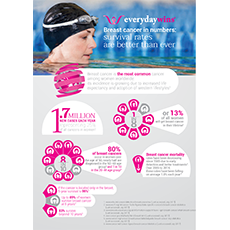What is Breast Cancer?
Today, breast cancer is the most common form of cancer in women worldwide, and each year there are about 1. 7 million new cases.1 Although breast cancer can affect men, it is almost entirely occurring in women.
Breast cancer develops when some cells in the breast harbour some abnormalities that allow them to multiply and grow abnormally.2 These cells form a growth called a tumour which can been seen on a mammography or felt as a lump.3 These cells can then invade surrounding tissues and spread to distant parts of the body, such as the lungs, bones or liver. This is called metastatic breast cancer. 2 Remember that not all breast tumours are cancer. Sorne breast tumours are benign and are not life-threatening.3
Most breast cancers develop in the ducts through which milk flows to the nipple, or less frequently in the lobules, which are the milk-producing glands. Although it is less common, breast cancer can also begin in other surrounding connective tissues of the breast.2
The reasons why cells behave in an uncontrolled way are not completely understood, but it has been shown that some factors can increase the risk of developing breast cancer. Remember that having breast cancer is not your fault and feeling guilty won’t help.4
Cancers are commonly divided into those that have oestrogen receptors (called ER+) and/or progesterone receptors (called PR+) and those that don’t.
If these hormone receptors are present on the cancer cells, they may help to promote the growth of the cancer. Generally about 80% of breast cancers are positive for hormone receptors.5 This is important since it helps determine if the cancer might respond to hormonal therapy or other treatments.6 Another important test that is performed involves HER2 status. If a cancer is found to be HER2+, meaning it makes the HER2 protein, this will also help your doctor in deciding how to best treat your cancer.7
While a round 85% of breast cancers occur in women with no family history of breast cancer,8 5-10% of breast cancers may be associated inherited gene mutations, the most common of which are those in the BRCA 1 and BRCA2 genes. ln general, for women with a BRCA 1 mutation the lifetime risk of developing breast cancer is 55-65%, and in those with a BRCA2 mutation, the risk is about 45%. Women with inherited mutations in these genes tend to develop breast cancers earlier than in women with sporadic breast cancer.9
References
- http://www.wcrf.org/int/cancer-facts-figures/data-specific-cancers/breast-cancer-statistics [[Last accessed June 2017].
- http://www.breastcancer.org/symptoms/understand_bc/what_is_bc [Last accessed November 2016].
- American Cancer Society. Breast Cancer Facts & Figures 2013-2014.
- https://www.cancer.org/cancer/breast-cancer/about/how-does-breast-cancer-form.html [Last accessed June 2017].
- http://www.breastcancer.org/symptoms/diagnosis/hormone_status/read_results [Last accessed June 2017].
- http://www.breastcancer.org/symptoms/diagnosis/hormone_status [Last accessed June 2017].
- http://www.breastcancer.org/symptoms/diagnosis/her2 [Last accessed January 2017].
- Haber G, et al.Am J Public Health. 2012;102(12): 2322-2329.
- http://www.breastcancer.org/symptoms/understand_bc/statistics [Last accessed June 2017].

Breast cancer in numbers: survival rates are better than ever
PDF - 601 Kb



